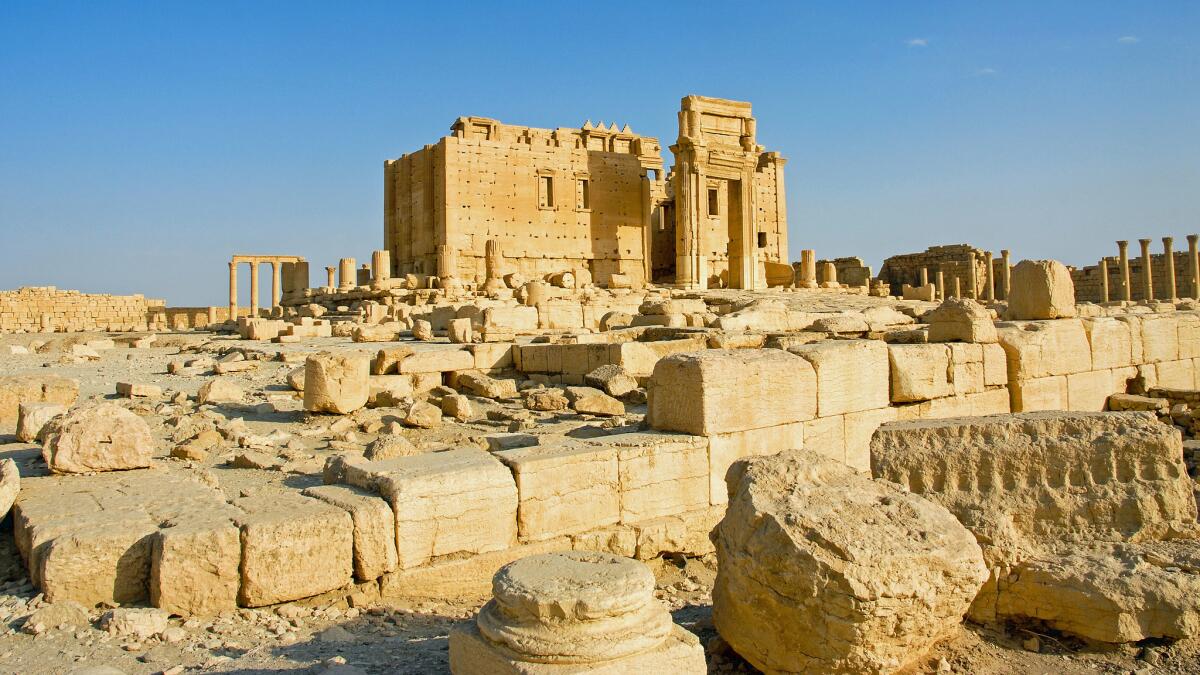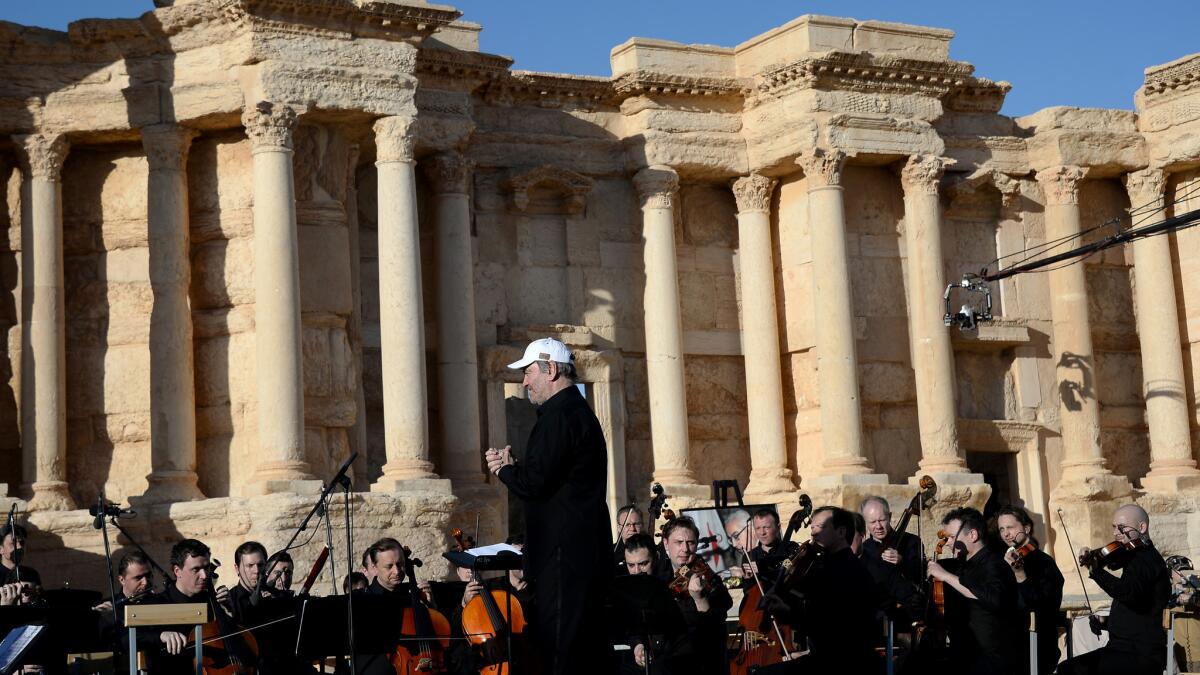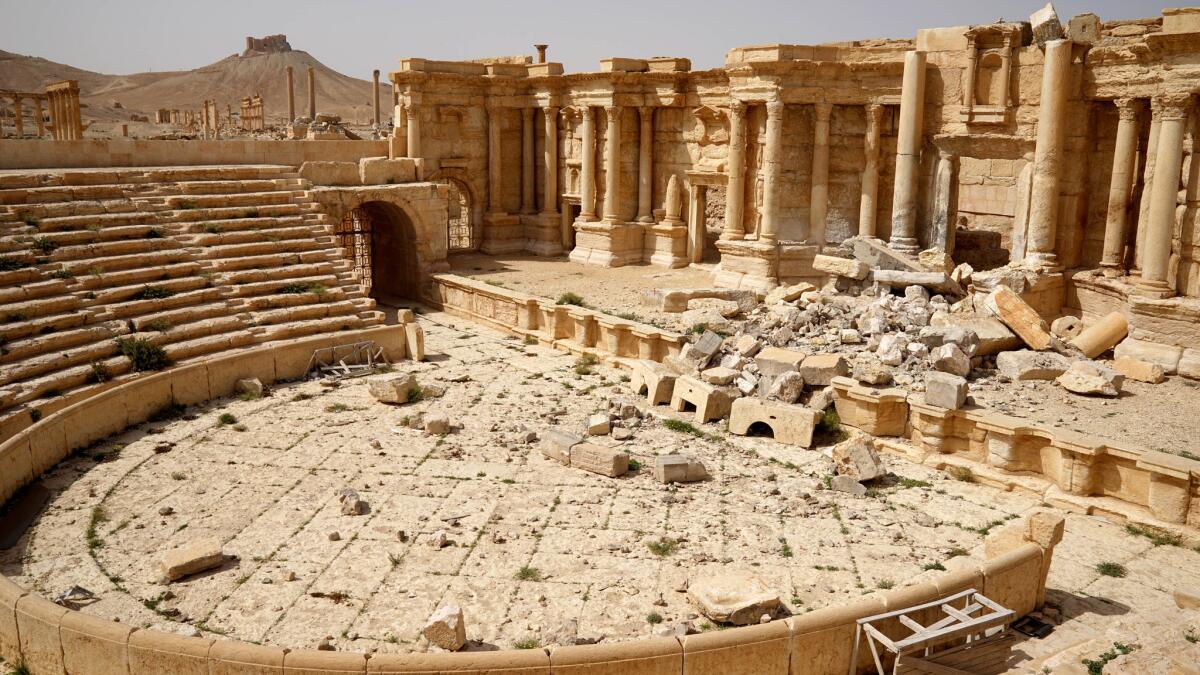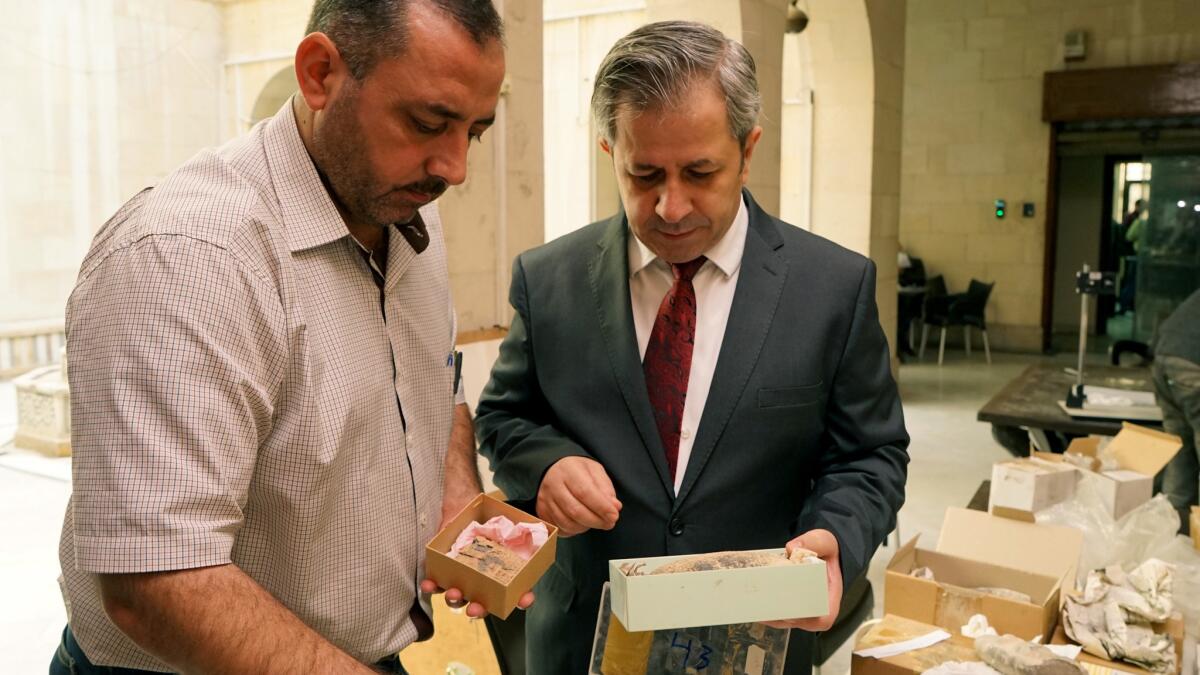ISIS militants battered Syria’s ancient Palmyra, but signs of splendor still stand
- Share via
Reporting from Palmyra, Syria — The once-resplendent Temple of Bel, dedicated to the principal deity of this ancient metropolis, has been reduced to a single sculpted arch rising gracefully from a jagged pile of tumbled columns and monumental stone blocks etched with grape vines and acanthus leaves.
Also leveled are the Temple of Baalshamin, a Semitic god of the heavens, and the Arch of Triumph, an iconic assemblage whose image is stamped on Syria’s 10-pound coin.
Still standing, however, are most of the stately colonnades lined up for nearly a mile along the main boulevard.
The fate of the historic city has remained a question mark since Islamic State militants who controlled it were driven out in March for the second time. The Los Angeles Times, which negotiated multiple Syrian army checkpoints to travel here recently, is one of the first Western news organizations to survey the destruction.
Palmyra has emerged profoundly damaged but not obliterated.
That Palmyra — which sits in the Syrian desert next to a modern city with the same name — has endured, broken but recognizable, provides a measure of consolation following occupation by the extremists, who denounced its architectural splendor as idolatry.

In the 3rd century, the old city — featuring Greco-Roman, Persian and indigenous influences — was a caravan oasis, a majestic crossroads of the Mediterranean world and Eastern cultures. Then in the year 273, the Romans put down a rebellion here, beginning centuries of decline. Herders, nomads and tribal villagers were living here when intrepid Westerners began visiting in the 17th century. The ruins eventually became a major tourism site, with tens of thousands of visitors a year before Syria erupted in war in 2011.
Islamic State first overran the city in May 2015 and began methodically dismantling the ruins with explosives.
That month, the militants used the storied Roman theater to stage the public slaughter of two dozen Syrian government soldiers. A black Islamic State flag strung from the theater facade provided an ominous backdrop for the executions, witnessed by children and other civilians, captured on video and posted on the Internet.
Three months later, the militants beheaded Khaled Asaad, the octogenarian former curator at Palmyra whose family had helped evacuate artifacts as Islamic State forces approached. The killers left a placard on his mutilated corpse labeling him an “apostate,” “director of idolatry” and participant in “infidel” academic gatherings.
He was one of 15 “archaeological martyrs” killed across the country as they bartered with the insurgents, smugglers and others in a bid to shield Syria’s archaeological treasures.
Syrian forces and their Russian allies retook Palmyra in March 2016 and two months later used the theater to celebrate with a victory concert by the famed Mariinsky Orchestra of St. Petersburg, Russia.

UNESCO, the United Nations’ cultural agency, conducted a “rapid assessment mission” around that time and labeled the demolition a “war crime” and “act of cultural cleansing.” The destroyed artifacts included statues and sarcophagi that were too heavy to evacuate from the museum and wound up “defaced, smashed, their heads severed, their fragments left lying on the ground.”
The U.N. agency — which lists Palmyra as a World Heritage site — also concluded that “despite the destruction of several iconic edifices, the archaeological site of Palmyra retains a large part of its integrity and authenticity.”
But then in December, after Syria and Russia redeployed their troops to focus on retaking the city of Aleppo, Islamic State militants staged a counterattack on Palmyra and seized it again, prompting a new wave of destruction.
This time, the militants set off explosions at the awe-inspiring Tetrapylon, four pillars on a raised platform that embodied the grandeur during the celebrated reign of Queen Zenobia, the cultivated monarch of the 3rd century. It is now a heap of debris.
They also inflicted serious but possibly not irreparable damage to the Roman theater, where shards of ornamental masonry from the blown-up facade now litter the stage.
The occupiers had almost three months to destroy what they had missed the first time. The militants were driven out of Palmyra again in March, though they remain nearby.
On Thursday, the Russian government announced its cruise missiles had struck Islamic State positions east of the ancient city.

Today, Islamic State militants remain within striking range of Palmyra, though Syrian and Russian soldiers protect the ruins along with the mostly abandoned town.
Demining operations continue in some parts of the sprawling Palmyra complex, which includes a large necropolis and medieval-era citadel outside the old city walls. Much of the expansive zone has never been excavated.
Conservationists are calling for a global campaign to restore the site once security is completely reestablished.
“We are hopeful that, with international help, Palmyra can return almost to the point where it was before the war,” said Maamoun Abdulkarim, who has been Syria’s director of antiquities, director of the National Museum in Damascus and chief “Monument Man” since 2012.
Abdulkarim, a French-educated archaeologist of Armenian and Kurdish ancestry, oversees a vast operation to safeguard the historical legacy of Syria. He has often lamented that he has “the world’s saddest job,” scuffling to save thousands of historic sites and countless artifacts scattered across the war-ravaged nation.

Syria’s heritage faces threats not only from bombs and artillery but also from well-organized gangs of thieves who seized on the breakdown in law and order as an opening to launch a methodical pillaging of treasures. Artifacts-trafficking into neighboring Turkey, Lebanon and Jordan became a major financing mechanism for Islamic State and other militant factions.
From the outset of the war, Syrian authorities were keen to avoid the cultural calamity of neighboring Iraq, where occupying U.S. forces in 2003 did little to prevent the looting of the National Museum in Baghdad and the torching and pillaging of Iraq’s National Library and Archive.
“We absolutely didn’t want what happened in Baghdad to happen here,” said Abdulkarim, a father of two who yearns to return to his scholarly pursuits at Damascus University. “We refuse to lose our national memory.”

The preservation effort saw tens of thousands of pieces — including pre-Babylonian-era tablets with cuneiform script, one of the oldest forms of writing — evacuated from regional museums and historical sites, including 400 statues and other pieces from Palmyra. Rescued artifacts were cataloged and hidden for safekeeping.
Many precious objects remain hidden in contested territory.
To help safeguard artifacts, the government antiquities department has kept paying the salaries of hundreds of employees throughout the country, even as the war has torn Syria apart. Though plunder has taken a toll, Abdulkarim expressed confidence that “the great majority” of the country’s cultural birthright has been preserved.
Among the first items that Islamic State militants smashed here was one of Palmyra’s most beloved symbols: The Lion of al-Lat, a 15-ton stone likeness of a wide-eyed lion that stood more than 9 feet tall shielding a horned gazelle between its massive paws.
The statue, which was unearthed in the 1970s in a Polish archaeological dig, for years graced the entrance to the Palmyra museum and frequently turned up in visitors’ snapshots. Its pieces now sit in the grounds of the National Museum.
Ironically, the lion was a symbol of protection associated with Al-Lat, a pre-Islamic female deity. On its left paw, written in the Palmyrean dialect, is an inscription: “May Al-Lat bless whoever does not shed blood in this sanctuary.”
Special correspondent Liliana Nieto del Rio contributed to this report.
twitter: @mcdneville
ALSO
What’s that drone flying in over the horizon? It’s a scout from Islamic State
More to Read
Sign up for Essential California
The most important California stories and recommendations in your inbox every morning.
You may occasionally receive promotional content from the Los Angeles Times.










